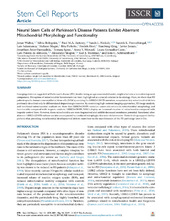Neural Stem Cells of Parkinson's Disease Patients Exhibit Aberrant Mitochondrial Morphology and Functionality.
Walter, Jonas; Bolognin, Silvia; Antony, Paul M.A.; Nickels, Sarah L.; Poovathingal, Suresh K.; Salamanca, Luis; Magni, Stefano; Perfeito, Rita; Hoel, Fredrik; Qing, Xiaobin; Jarazo, Javier; Arias-Fuenzalida, Jonathan; Ignac, Tomasz; Monzel, Anna S.; Gonzalez-Cano, Laura; Pereira de Almeida, Luis; Skupin, Alexander; Tronstad, Karl Johan; Schwamborn, Jens C.
Peer reviewed, Journal article
Published version

Åpne
Permanent lenke
https://hdl.handle.net/1956/22602Utgivelsesdato
2019-04-11Metadata
Vis full innførselSamlinger
Originalversjon
https://doi.org/10.1016/j.stemcr.2019.03.004Sammendrag
Summary Emerging evidence suggests that Parkinson's disease (PD), besides being an age-associated disorder, might also have a neurodevelopment component. Disruption of mitochondrial homeostasis has been highlighted as a crucial cofactor in its etiology. Here, we show that PD patient-specific human neuroepithelial stem cells (NESCs), carrying the LRRK2-G2019S mutation, recapitulate key mitochondrial defects previously described only in differentiated dopaminergic neurons. By combining high-content imaging approaches, 3D image analysis, and functional mitochondrial readouts we show that LRRK2-G2019S mutation causes aberrations in mitochondrial morphology and functionality compared with isogenic controls. LRRK2-G2019S NESCs display an increased number of mitochondria compared with isogenic control lines. However, these mitochondria are more fragmented and exhibit decreased membrane potential. Functional alterations in LRRK2-G2019S cultures are also accompanied by a reduced mitophagic clearance via lysosomes. These findings support the hypothesis that preceding mitochondrial developmental defects contribute to the manifestation of the PD pathology later in life.
